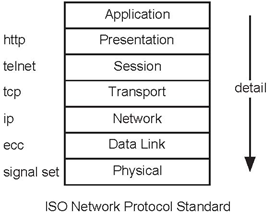The complexity of information transmission in a computer network reliable transmission of bits across a channel, routing, and directing information to the correct destination within the destination computers operating system demands an overarching concept of how to organize information delivery. No unique set of rules satisfies the various constraints communication channels and network organization place on information transmission. For example, random access issues in Ethernet are not present in wide-area networks such as the Internet. A protocol is a set of rules that governs how information is delivered. For example, to use the telephone network, the protocol is to pick up the phone, listen for a dial tone, dial a number having a specific number of digits, wait for the phone to ring, and say hello. In radio, the station uses amplitude or frequency modulation with a specific carrier frequency and transmission bandwidth, and you know to turn on the radio and tune in the station. In technical terms, no one protocol or set of protocols can be used for any communication situation. Be that as it may, communication engineers have found that a common thread runs through the organization of the various protocols. This grand design of information transmission organization runs through all modern networks today.
What has been defined as a networking standard is a layered, hierarchical protocol organization. As shown in Figure 6.30 (Protocol Picture), protocols are organized by function and level of detail.

Protocols are organized according to the level of detail required for information transmission. Protocols at the lower levels (shown toward the bottom) concern reliable bit transmission. Higher level protocols concern how bits are organized to represent information, what kind of information is defined by bit sequences, what software needs the information, and how the information is to be interpreted. Bodies such as the IEEE (Institute for E lectronics and Electrical Engineers) and the ISO (International Standards Organization) define standards such as this. Despite being a standard, it does not constrain protocol implementation so much that innovation and competitive individuality are ruled out.
Segregation of information transmission, manipulation, and interpretation into these categories directly afects how communication systems are organized, and what role(s) software systems fulfll. Although not thought about in this way in earlier times, this organizational structure governs the way communication engineers think about all communication systems, from radio to the Internet.
Exercise 6.37.1
How do the various aspects of establishing and maintaining a telephone conversation ft into this layered protocol organization?
We now explicitly state whether we are working in the physical layer (signal set design, for example), the data link layer (source and channel coding), or any other layer. IP abbreviates Internet protocol, and governs gateways (how information is transmitted between networks having different internal organizations). TCP (transmission control protocol) governs how packets are transmitted through a wide-area network such as the Internet. Telnet is a protocol that concerns how a person at one computer logs on to another computer across a network. A moderately high level protocol such as telnet, is not concerned with what data links (wireline or wireless) might have been used by the network or how packets are routed. Rather, it establishes connections between computers and directs each byte (presumed to represent a typed character) to the appropriate operation system component at each end. It is not concerned with what the characters mean or what programs the person is typing to. That aspect of information transmission is left to protocols at higher layers.
Recently, an important set of protocols created the World Wide Web. These protocols exist independently of the Internet. The Internet insures that messages are transmitted efciently and intact; the Internet is not concerned (to date) with what messages contain. HTTP (hypertext transfer protocol) frame what messages contain and what should be done with the data. The extremely rapid development of the Web on top of an essentially stagnant Internet is but one example of the power of organizing how information transmission occurs without overly constraining the details.
- 瀏覽次數:2295






